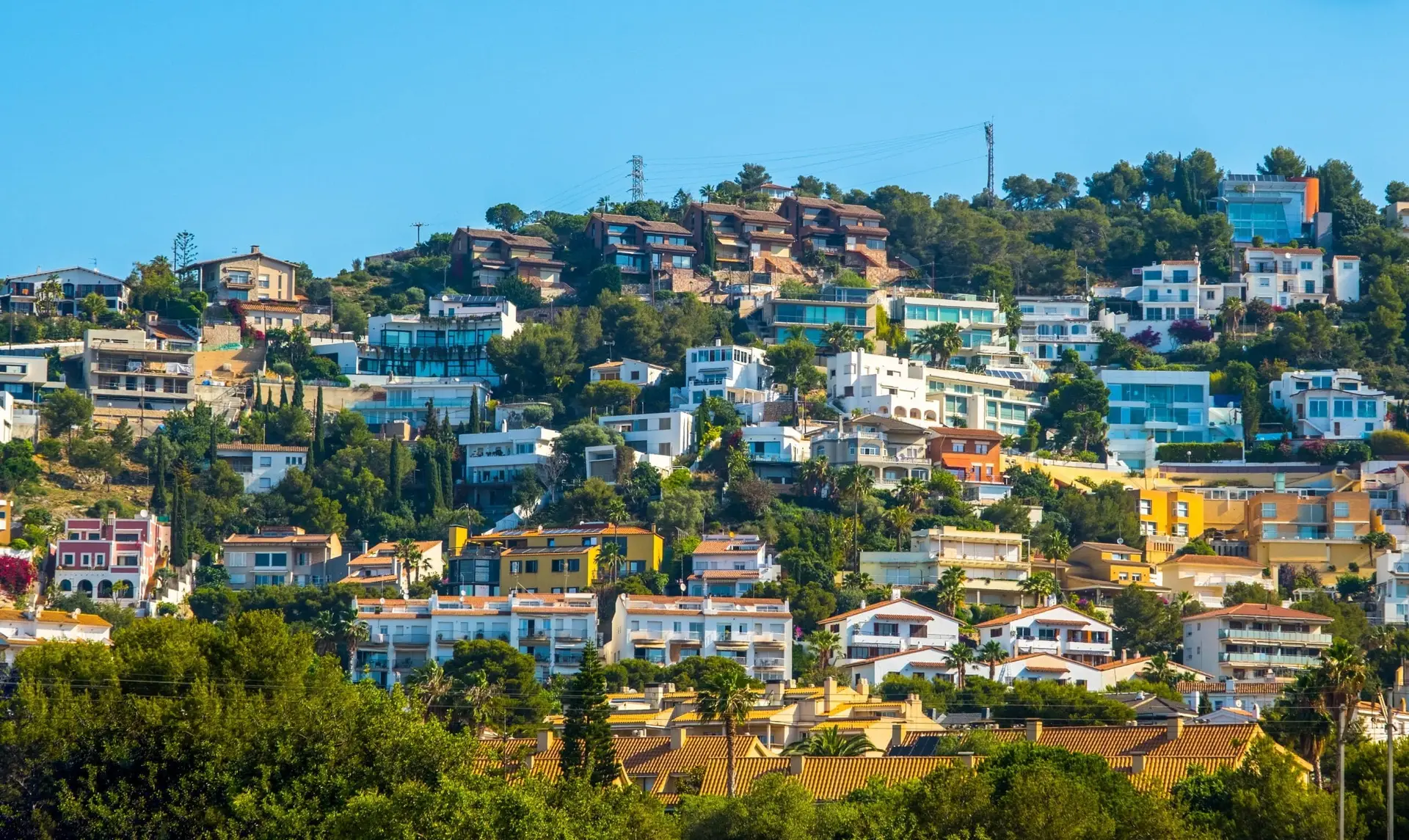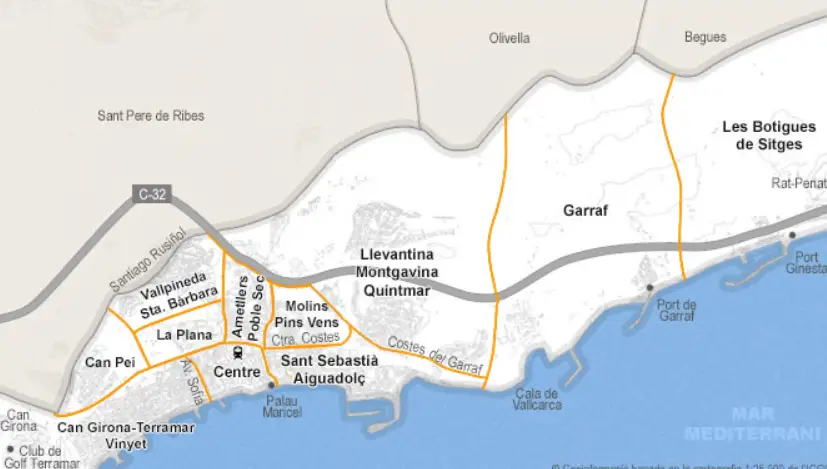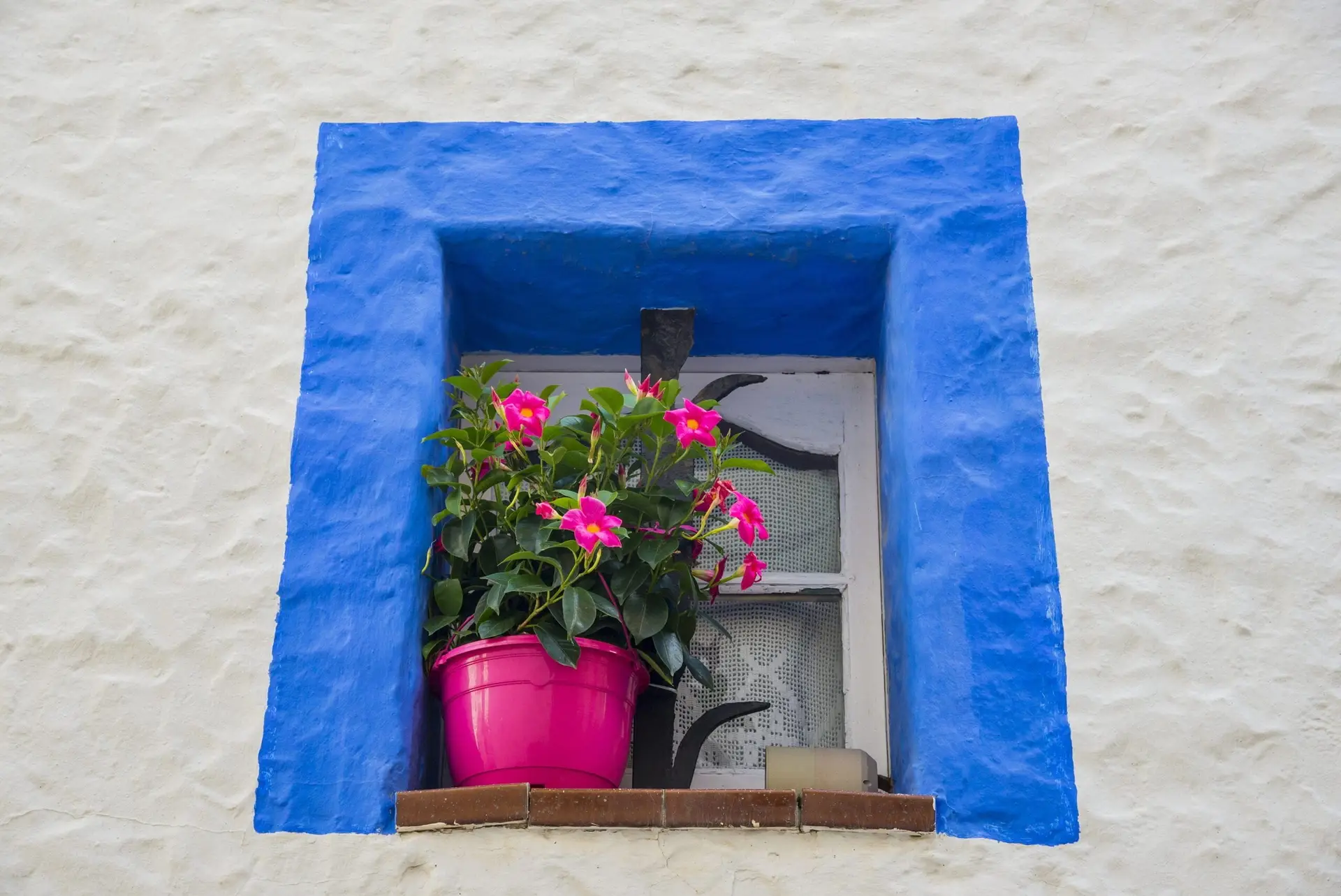
Guide: Rent, Sell or Buy Property Sitges
If you want to rent, sell or buy property, Sitges offers you great options. Here is our guide to the terminology, processes and costs involved. See also our property listings.
Buying or Selling a Property
Costs for Buyers
In Sitges/Catalunya you will need to add around 11-15% onto the purchase price. This includes:
A transfer tax (ITP) of 10% for houses up to €1 million (11% beyond this). This is reduced to 5% in certain circumstances, eg if you have 3 or more children and have a ‘familia numerosa’ card, or if you are under 32 and earn under 30k per year. If the property is a new build, you do not pay the ITP. Instead, you pay VAT at 10% and AJD (to get the new build documented) at 1.5% (reduced for protected housing, or for people under 32 or with registered disabilities).
Contrato de arras (the pre-sale agreement involving the payment of a deposit and possible penalties for any party who withdraws): A good agent may provide this as part of the selling process. However, you may decide to ask a lawyer to draw one up for you. Cost: 200-500€ depending on the contract compexity.
Notary fee (for drawing up the deed and officiating over the signing). In Catalunya these are paid by the buyer unless you specifically agree with the seller to the contrary. (Which notary to use and where is usually chosen by the buyer too, although in practice a mutually convenient location is often agreed with the seller). The fee is regulated by the state but will depend on the number of pages in the deed and various other factors including the price of the house. The fee is likely to be between 600-1200 euros for most people, but could be more or less, depending on your situation.
Registry Fee (to have the new owners officially registered). This is usually around 400-750 euros.
Lawyer fees. Your lawyer should check the property’s legal documents and see that it has no outstanding debts (eg taxes or community fees) or extensions etc that haven’t been properly declared. They will also oversee the transfer tax and land registry payments and processes. It’s not compulsory to use a lawyer, although many people would consider it to be necessary.
Bank fees for transferring to the vendors or for providing you with a cheque nominativo to purchase the property with.
Mortgage fees: Obviously these will depend heavily on which bank you choose, what deposit you have, and what interest rates are on offer. However, before obtaining any mortgage you will likely have to pay for the property you have in mind to be valued by the bank. This is called a tasación. The fee for this will depend on the property but is likely to be between 350 and 600 euros.
NB if you are buying from someone who is not officially resident in Spain, you will have to withhold 3% of the sale price to cover the seller’s capital gains (plusvalia fiscal) obligations, and pay their municipal capital gains (plusvalia municipal) obligations (also deducted from the sale price). Consult your agent and/or lawyer about this.
Costs for Sellers
The cost of selling a property may include the following:
Estate agent fee: typically around 3-5% of the selling price, to include photos; listing on major portals; managing enquiries, showing the property, etc
Certificado energetico (to show how energy efficient your property is): If you don’t already have it from when you purchased your property. About 50 euros.
Cedula de habitabilidad (to prove your property is habitable): If you don’t already have it, it will cost 50-100€.
Capital gains taxes: Plusvalia fiscal. This is payable to the national tax office on any profit you make on the sale price. If the property is your main residence, then any part of that profit which is spent on a new main residence anywhere in the EU (within 2 years) is exempt. If you are 65 or over you will also be exempt, even if you do not reinvest the money in a new main residence. A property is your main residence if you have been living there (with the empadron that proves this) for at least the last 3 years (the tax office may also study other factors).
The rates of plusvalia fiscal in Catalunya in 2023 are as follows:
0-5.9k: 19%
6-49.9k: 21%.
50-199.9k: 23%.
200k and above: 26%.
NB If you are a selling and you are not officially resident in Spain, the buyer has to withhold 3% of the purchase price to cover your plusvalia fiscal obligations, and they must pay the plusvalia municipal on your behalf, which is also then deducted from the sale price. Consult your agent and/or lawyer about this.
Capital gains taxes: Plusvalia municipal. This is payable to your local townhall, by everyone except those who have lost money on the sale. There are now two different ways of calculating this, so people can choose the one which works out cheaper for their situation. One is called the objective method (metodo objetivo) and the new one is the real method (metodo real). The former uses any increase in the ´valor catastral’ (ie a land value set by the town hall) whereas the latter uses the any increase between the original purchase price and the sale price. In each method, the resulting figure is then subjected to calculations set by the town hall, based on factors which vary depending on how long you have owned the house (they are lower the longer you have owned for). Fees will obviously vary, so it is good to check your situation with your agent and/or lawyer.
Mortgage cancellation fees: You will want to sell your house or apartment ‘libre de cargas’ so you will need to cancel any outstanding mortgage. The fee for this will vary depending on your mortgage provider, but can be, for example, 2% of the remaining balance within the first 10 years, or 1.5% thereafter.
Typical House Sale Process
Most processes look something like this:
Seller signs agreement with agent, who takes professional photos, gives pricing advice based on local data, and helps owner to check all documentation is in order. Property is listed on major portals. Remote and in-person showings begin.
Buyer makes verbal offer. Agent may assist with negotiations. In the meantime, buyer’s lawyer will request all the documentation for the house. When verbal agreement is reached, a contrato de arras is drawn up (a good agent may do this, or one of the parties may instruct a lawyer) and 10% of the agreed price is paid, in order to reserve the property. The contract states when the full sale and handover will take place. There are 3 types of contrato de arras. The most common is the contrato de arras penitenciales, which states that if either party withdraws, they pay the other 10% of the agreed price (ie the buyer loses their deposit, whereas the seller returns the deposit and pays the same amount again to the buyer). In Catalunya, if the buyer is unable to get financing from their designated provider during the designated time, they may withdraw without penalties. In the rest of Spain, this is not the case unless it is stated specifically in the arras. NB The 2 other types of arras, and also the sometimes used contrato de reservas allow a party to sue a withdrawing party for further damages.
Buyer and seller go to the notary on the agreed date (notary usually chosen by the buyer, although in practice a mutually convenient location is usually agreed & it will often be near the property in question). Buyer hands over a cheque nominativo for the oustanding amount (can also carry out a transfer and give the receipt). Seller hands over the keys. Deeds are signed.
NB It is not as common to carry out a survey of a property prior to purchase in Spain as it is in some other countries. However, older buildings (usually 40yrs +) are subject to an ITE (technical inspection) every 10 years, and your lawyer can check this. There is also ‘vicios ocultos’ legislation which allows a buyer to claim for any serious defects they discover in the house (and which were hidden by the seller or unknown by the seller) within a specific period after the purchase. This is usually limited to serious issues such as those with the structure, or the water or electric systems. If such problems are detected and were previously hidden, the usual process is to sort it out amicably with the vendor, by way of repairing the issue. If this doesn’t work, there are legal processes which can be followed. Check with your lawyer.
Note on Inheritance Tax
The following is intended as a general guide/overview. Please also seek professional advice.
In Catalunya, inheritance tax is paid directly by the beneficiary, not by the estate of the deceased person, as is the case in some countries. Moreover, the inheritance tax is payable in Catalunya on assets based in Catalunya (eg property) regardless of where the beneficiary resides.
In Catalunya, if you have not written a will, then your assets automatically go to your children (not your spouse), with the spouse becoming the usufructuary of the inheritance for life. For example, if your partner passes away without writing a will and you owned your house 50/50 with them, and if you have 1 child, then that child would become liable for taxes on 50% of the house, as this would automatically pass to them.
Inheritance taxes in Catalunya vary according to your relationship with the deceased. For example, children under 21 are in Group 1, whereas spouses, children over 21, parents of the deceased, or grandchildren are in Group 2. Siblings are in Group 3, and all others are in Group 4. The amount owed is calculated by taking the asset value that you have inherited, then applying certain discounts (according to your relationship to the deceased and other factors, eg if the asset is your main residence) and then multiplying this by a coefficient depending on your overall wealth
So, in 2023, Group 1 had a deduction of €100k, plus a further €12k for each year under 21yrs of age, up to a maximum of €196k, whereas for group 2, spouses and adult children had deductions of €100k, and parents or grandchildren of the deceased had €50k. There are also additional discounts, for example, if the asset is the main family home, then a reduction of 95% of the value applies, up to €500k.
Tax rates applicable on the remaining asset value after deductions in 2023 were applied by taking a remaining asset value range (eg €50k-149.99k) and applying a flat rate on the first number of the range (eg €3.5k for the first €50k) and then a percentage on the remainder up to the top of the range (eg 11% in 2023). This is then multiplied by a coefficient which depends on your current wealth. So, if after your discounts, you received assets of €100k, you would firstly be liable for €3.5k on the initial €50k, plus 11% of the remaining €50k. This amount would then remain the same if your overall wealth is up to €500k (because it would be multiplied by a coefficient of 1). However, if your overall wealth is between €500k and €2m, the amount owing would be multiplied by 1.1, in order to arrive at the final amount. Depending on the year, further discounts can still be applied on the overall result, depending on your relationship to the deceased, so it is a good idea to seek professional advice as soon as you can.
Building/Refurbishing Permits
The information in this section is kindly provided by Viz Arquitectes, an English speaking architect practice based in Vilanova and with many years of experience operating in Sitges.
Types of Building Permit & Requirements
BUILDING PERMITS
If you are planning to alter or refurbish your property, including the outside spaces, you are likely to need a permit. There are 3 classes of permit and various types within each class. Read on to find out more:
Building permits in Sitges are divided into three categories:
- Notification
- Minor Works
- Major Works
NOTIFICATION
Definition
Minor building works with a value of less than 12,000€, excluding works to listed buildings. These include:
- Interior works that do not affect the structure or the interior layout of the building.
- Plastering or painting existing walls or ceilings
- Replacing flooring or ceilings
- Replacing interior doors or fitted furniture
- Replacing kitchen or bathroom fittings
- Upgrading electrical, plumbing and gas instalations
- Site clearance excluding tree felling
Requirements
- Submit notification of intention to carry out the works (Instancia), including NIE of the property owner
- ID and contact details of the Contractor
- Location plan
- Description of the work
- Estimated costs
The above information should be presented to the OAC, and the Council will then issue an invoice for the construction tax based on the value of the works, which must be paid before works commence. If there is no adverse commentary from the Council within 1 month then work may commence.
It is not obligatory to use an architect or engineer for the licence application.
MINOR WORKS
Definition
TYPE A
- Construction of swimming pools, cisterns etc
- Rehabilitation and/or repair of buildings & facades in general
- Any increase in volume but not floor area
- Specific modifications to the structure of the building
- Modifications to communal areas
- Retaining walls and earth movement
- Partial demolition
- New bathrooms in commercial premises
- Lift instalation
- Modifications to interior distribution without affecting the structure
TYPE B
- Scaffolding > 6m high
- Facade repairs requiring scaffolding > 6m high
- New openings to the facades or modifications of existing
- Repairs to balconies
- Party wall impermeabilization
- Septic tanks & drainage
- Propping of facades
- Garden walls
- Repairs to roofs and terraces without affecting the structure
TYPE C
- Kitchen extractor to exterior
- Instalation of air conditioning, heat pumps or antennas
- Fixed barbecues
- Replacement windows & blinds
- Replacement exterior pavements & stairs
- Facade repairs < 6m high
- Replacement of rainwater pipes < 6m high
- Tree felling
Requirements
- Submit notification of intention to carry out the works (Instancia), including NIE of the property owner
- Receipt of payment of construction tax (4% of construction cost + 0.95%)
- ID and contact details of the Contractor
And:
TYPE A
- Technical project by competent professional stamped and approved by the relevant professional institute (PDF & hard copies)
- Photographs
- Certificate of responsibility of competent professional for the supervision of the building works
- Health & Safety project
- Residue management proposal
TYPE B
- Technical project by competent professional (PDF & hard copies)
- Photographs
- Certificate of responsibility of competent professional for the supervision of the building works
- Residue managment certificate
TYPE C
- Project indicating location, scope of works & estimated budget (PDF & hard copies)
- Photographs
Minor Works licences types A & B require the appointment of a recognised professional (Architect, Technical Architect or Engineer), and the elaboration of a project, which in the case of type A would need to be submitted to the Architect’s Institute along with a Health and Safety project and residue managment proposal for approval.
Permission should be legally granted 1 month after submission, although in reality it takes longer despite the prevision for “Silenci Administriu”, which automatically concedes permission after 1 month without adverse commentary from the Council. The building works should commence within six months of the concession of the licence, and finish within 12 months.
MAJOR WORKS
Definition
- All new buildings
- Demolition of existing buildings
- Major rehabilitation, extension or increase in volume of existing buildings
- Modifications to the number of residential or commercial units within an existing building
- Change of use for existing buildings
- Subdivision of industrial buildings
- Mezzanine construction in existing buildings
- Modifications to existing facades
- Building works to listed buildings
Requirements
The project must comply with the Municipal regulations regarding ecoefficiency and water management
- Submit notification of intention to carry out the works (Instancia), including NIE of the property owner
- Land Registry reference (Cadastre)
- Technical project by competent professional stamped and approved by the relevant professional institute (PDF & hard copies)
- Certificate of responsibility of competent professionals for the supervision of the building works and Health & Safety coordination
- Health & Safety project
- Residue managment proposal
- Quality Control project
- Telecommunications project
- ID and contact details of the Contractor
- Statistical certificate
- High Tension cable certificate
- Technical report from water company (SOREA)
- Topographical plan including existing trees
- Demolition insurance certificate
- Receipt of payment of construction tax (4% of construction cost) + 2% for new buildings, or 1.5% for existing buildings.
The appointment of an architect/technical architect/engineer is obligatory for all major works, both for the elaboration of the project and for the supervision of the construction works and coordination of health & safety.
Permission should be legally granted 2 months after submission, although in reality it takes longer despite the prevision for “Silenci Administriu”, which automatically concedes permission in most cases, assuming that all of the documentation listed above accompanies the application and complies with the relevant building, planning and municipal regulations. The lack of response from the Council is only positive in certain specific circumstances, and if any part of the application is deficient, then the Council reserves the right to reject the application, the lack of response becomes negative and the whole procedure could be significantly delayed. The building works should commence within six months of the concession of the licence, and finish within 18 – 30 months depending on the size of the project.
.
GENERAL ADVICE
It is advisable to consult with a registered construction professional before embarking on any building works for the following reasons:
- The type of licence required can easily be determined before any expenses are incurred
- The correct procedures can be identified, professionals appointed if required, and costs estimated
- The duration of the complete process can be estimated (for example, some building proceedures are banned or restricted during the summer)
The competent professionals recognised by Spanish law for the design, supervision and certification of residential building works are architects (design, supervision and certification), technical architects (quality control, supervision and certification). Engineers are restricted to the design and construction non-residential buildings. Project managers, Interior designers and decorators are legally representatives of the client but not recognised under Spanish Construtcion Law (LOE 1999) as “Agentes de la Construcción”. Surveyors do not exist, so building inspections and reports are carried by the competent professional according to the registered use of the building
A good architect can usually determine which permit you need; obtain it for you; and manage the project in accordance with local regulations.
The information in this section is kindly provided by Viz Arquitectes, an English speaking architect practice based in Vilanova and with many years of experience operating in Sitges.
Renting (for Tenants & Property Owners)
Types of Contracts & Laws
Types of rental in Sitges
- Seasonal: You can rent a property for a specific time period using a contrato de temporada/de uso distinto a vivienda so long as the reason for using this type of contract and the length agreed between the parties is justified in the contract (usually, it is stated that the tenant needs the property for work or study reasons, or similar). The duration of these contracts can actually be any period agreed by both parties, but the tenant will not have the same rights/protections of up to 5 years of tenancy that they have in a normal rental contract. For this reason, they are usually used when there is some other advantage for the tenant; for example, the rent is lower than usual because it is agreed that the tenant will not be there during the summer months. If you go for this type of contract & you’re planning on staying more than 90 days, it’s probably a good idea to add a clause stating that the landlord will give their authorisation for you to get a certificado de empadronamiento as you will need this from the town hall, and they may expect a ‘normal’ rental contract to be shown before you can get it. NB This type of contract is not currently subject to the property law which came into force in May 2023. However, the new law provides for a working group to spend 6 months studying how to incorporate this type of contract into the law.
- Long term: ‘Normal’ contrato de arrendamiento rental contracts involve a tenant having the right to renew the contract for up to 5 years, even if the contract is for 1 year. During this time, the rent can only increase according to the consumer price index, and only if this is stated in the contract. Note that in some circumstances a property owner can require the property back after the first year, but only if they need it for specific reasons for themselves or for their parents or children (in which case they must give 2 months’ notice and move in within 3 months after the tenant has left). Finally, rental contracts (probably including seasonal contracts) are likely to be subject to rent controls in the near future. Properties in Sitges were briefly subject to such controls, but the Catalan law was struck down by Spain’s supreme court so that a national law could be made instead. Watch this space!
- Tourist rentals: In Sitges, a property needs a tourist license from the town hall before it can be used for tourist rentals. There has been a moratorium on new licenses for about 7 years and Sitges passed a law which prevented licenses being passed on with a property when it is sold. After the law had been in place for many months, it was recently struck down by Catalunya’s supreme court, and so is no longer in effect (yes, laws can be a minefield!) The town hall also limits the number of licensed properties so that they will never make up more than a determined percentage of the town. However, since a lot of new housing stock has been developed in the town over the last 6 or 7 years, it is expected that some new licenses will be available in the near future. Note also that if a property is part of a ‘comunidad’, a property owner would need to check whether such activities are allowed by the comunidad before applying for a tourist licence.
Costs for Property Owners & Tenants & Rent Price Laws
The cost of renting a property may include the following:
For property owners & tenants
Estate agent & ‘contract’ fees
According to the new law, all estate agent fees must be paid by the property owner, so long as the contract is the typical rental contract valid for up to 5 years.This is the same for fees relating to the drawing up of the contract.
If a contrato de temporada is being offered instead, this must be clearly justified (see types of contract, above). In a contrato de temporada, the estate agency fees can still be payable by the tenant if this is stated in the contract.
Deposits
A deposit is usually equivalent to one month’s rent, although you may be asked for more if you don’t have proof of regular funds.
The deposit must be placed in INCASOL by the owner, and the property owner must give the tenant proof that it’s been placed there.
It’s a good idea to take photos of the condition of the house and any issues, and have the property owner sign this when you move in.
If a property owner is intending to retain any part of your deposit, ask for a written justification of why. This may have more effect if you send it via a lawyer, and by Burofax. If the owner cannot justify their allegations, this is often enough to remind them to act according to the law. Remember, they may be justified in their allegations, in which case they have the right to retain part of the deposit. If there are outstanding utility bills when you leave, a small part may be retained until the bills arrive.
Rental controls & laws
In ‘normal’ (5 year) rentals, these can only usually be increased by the consumer price index (IPC). However, the can be accumulated (though not backdated). For example, if the IPC was 3% each year from 2020-2023 but the property owner didn’t increase the rent, then they could choose to increase it by 9% for 2024, although they can’t ask you to pay any extra for years that have already passed.
Due to the huge increases in the IPC in recent years, the government has intervened to establish maximum rental increases, regardless of the IPC. For 2024, this will be 3%.
In February 2024, new rent controls are due to be introduced, affecting all future contracts. Each property will be subjected to a maximum permitted rent depending on its individual characteristics. This page will be updated as the situation becomes clearer.
Other fees
Comunidad is the monthly or quarterly fee paid to the community for upkeep of communal areas (may not apply for some independent houses). This is usually paid by the property owner but a contract could state that the tenant is reponsible.
A refuse tax, payable to the town hall, can be paid by the tenant or the owner, depending on what’s agreed in the contract.
Typical Rental Process
For property owners:
- Consult with a reputable agent on legal aspects, especially in the light of the new law. This may include appropriate rental price, length of tenure, permitted rental increases, responsibilities for other costs, etc.
- Decide on other issues eg furnished or not, attitude to pets or smokers, etc
- Supply agent with photos (good agents may also come to take their own and create a virtual tour)
- Supply agent with keys and information (eg average costs of utility bills etc) so that they can do effective in-person and virtual tours
- Receive details of prospective tenants and agree to go forward with one.
- Receive the draft contract and study it, then sign it.
- Place rental deposit in INCASOL
- Don’t forget to declare your rental income in your next declaración de la renta
For tenants
- Visit potential homes and choose one
- Gather together essential information: TIE or NIE/Passport and Spanish bank account details. If you have none of these and the property owner still wants to go ahead, you will need to use your passport and probably pay more up front.
- Pay the first month to reserve the property (this will then be used for your first month of rental). Never do this without receiving a signed receipt from an agent which includes the agent’s identifying name and fiscal identification number
- Receive the draft contract and study it. Communicate any queries
- Receive the final contract signed by the property owner
- Pay the deposit and sign the contract
- Receive notificiation from the property owner that your deposit has been placed with INCASOL.
Where to Live
Areas & Types of Houses
The amount of housing stock in Sitges has increased considerably over the last 10 years. Judging by the new developments springing up, this trend looks set to continue.
In Sitges there are apartments in the centre of town & also in the more reasonably priced Poble Sec, which people say has its own villagey atmosphere. Alternatively, there are houses with gardens that are walkable or cyclable into town, from parts of urbanisations like Levantina or Vallpineda. Many of the imminent new developments around La Plana look set to provide more family houses that are walkable to town. There is also a limited selection of townhouses (ie small terraced houses, dotted around). For those with deeper pockets, there are also houses and mansions that are walking distance from town, mostly in the area of Vinyet. And for those who don’t mind a 10-15 minute drive, houses with generous gardens can be had in several urbanisations that are not too far from Sitges or Sant Pere de Ribes, and around the village of Olivella.
In Sant Pere de Ribes there are some lovely townhouses in the old part of the town, as well as some modern detached houses and lots of apartments which are very close to the centre by foot. As with Sitges, there are also several urbanisations within easy reach by car for those who prefer semi rural living. Sant Pere is a friendly, international little town which is the preferred choice of more than a few community members.

If you are thinking of international schools for your kids, all of them are equally driveable from Sitges or Sant Pere (for more details on these and about which public schools are where, see our schools section).
If you are worried about noise, bear in mind that some areas of Sitges, especially the centre, host frequent fiestas and events throughout the year, although these are often very desirable areas for other reasons. Also, the train runs right through the town, although this is usually a background noise unless you are right next to the track, and it doesn’t run throughout the night.
Buying or Selling Property in Sitges?
I will be delighted to help you

About James
I came to work in Spain in 1995, shortly after graduating from St Andrews University in Scotland. I have spent most of my time in this country since then, apart from a couple of years gaining an MBA and working in London, and 5 years directing operations across Asia for a UK education charity. During my 20+ years in Spain, I feel like I’ve gained an honorary PhD in local bureaucracy: buying and selling properties; renting as both a tenant and an owner; running an Airbnb in Sitges; managing two Spanish education companies (and starting up a third); and negotiating almost every other bureaucratic hurdle, including birth and school registrations, changing a driving licence, getting a NIE/TIE, setting up as autónomo, and many more!
Over the years, I have helped many people with property sales and purchases in Spain, and with related official processes, both independently and in collaboration with leading international realtor/estate agency IAD. I really enjoy sharing my knowledge and experience, and this prompted me to set up the Sitges English Speakers Facebook community in 2015. It’s now the biggest private advice and support community in the area and is a trusted resource for many.
When helping you sell or buy property in Sitges, I aim to provide the kind of service my family and I appreciate whenever we find it in Spain: efficient, accurate, transparent and personable. It makes such a difference to feel your needs are understood and someone cares about you achieving them. This is what I strive for!
I generally cover an area including Sitges, Sant Pere de Ribes, Olivella, Canyelles, Vilanova and Castelldefels. If I can help you buy or sell property, do get in touch via the form below. I look forward to hearing from you.
How can I help?
If you want to sell your property
I offer you:
- Access to a wide range of potential buyers from Spain and overseas through my own network and via my collaboration with leading international property agency IAD.
- Professional property valuation based on extensive data from the Sitges market
- Professional photographs and a state of the art virtual tour
- Listings on major national and international portals, such as Idealista, Habitaclia, Rightmove Overseas, etc as well as on this site.
- Knowledgeable advice on all the legal aspects and costs of selling your property, accompanying you throughout the process (this does not constitute official legal advice as I am not a lawyer).
- Professional contracts
- Transparent, highly competitive rates
Contact me now, using the form below!
If you're looking for a place to buy
I offer you:
- Expert knowledge of the area and the processes, both as an agent working with leading property network, IAD, and as someone who has bought two properties in the area (this does not include official legal advice, as I am not a lawyer).
- Early access to my own and colleagues’ exclusive listings
- If you are currently outside Sitges, I can work with you remotely, acting as your buyer’s agent/personal shopper on the ground. My rates are transparent & highly competitive.
- If you like a property that is listed for sale with another agent, I can often collaborate with them at no additional cost to you. This means I will arrange visits and accompany you throughout the process, along with the other agent(s). This can be useful if you don’t speak Spanish and/or want to work primarily with one trusted person who is developing a good understanding of your requirements. (There are some agents who will not collaborate with others. However, most will for sales, so it’s always worth checking).
Contact me now, using the form below!

Contact me
Share this page:




